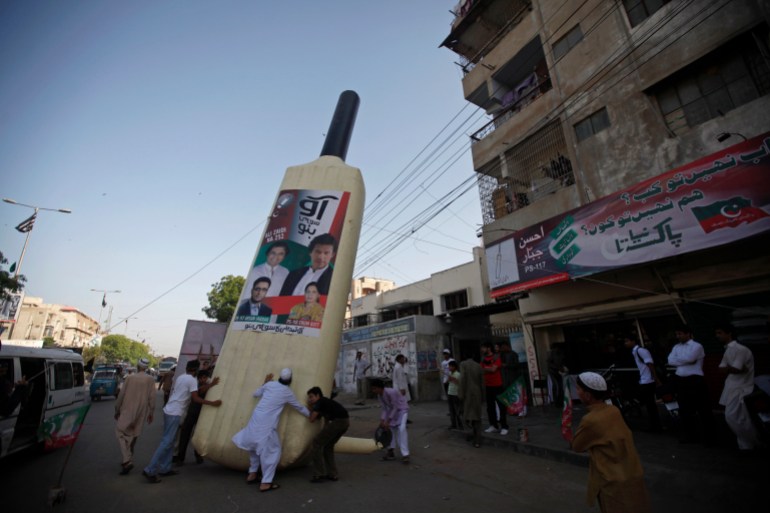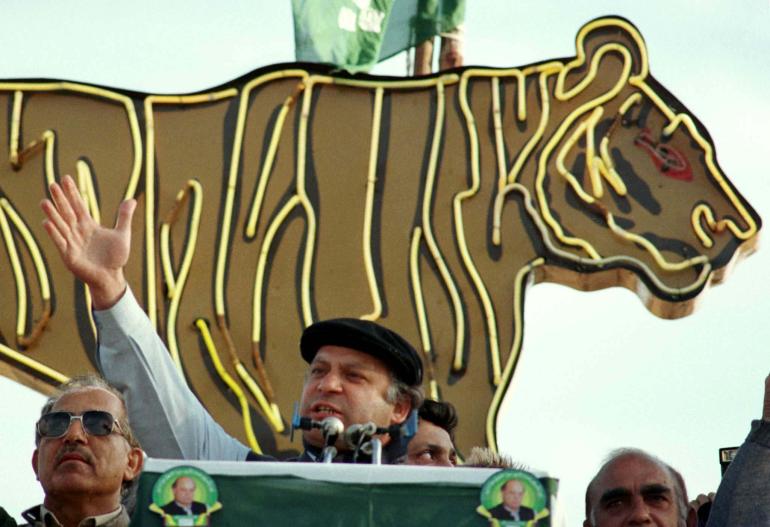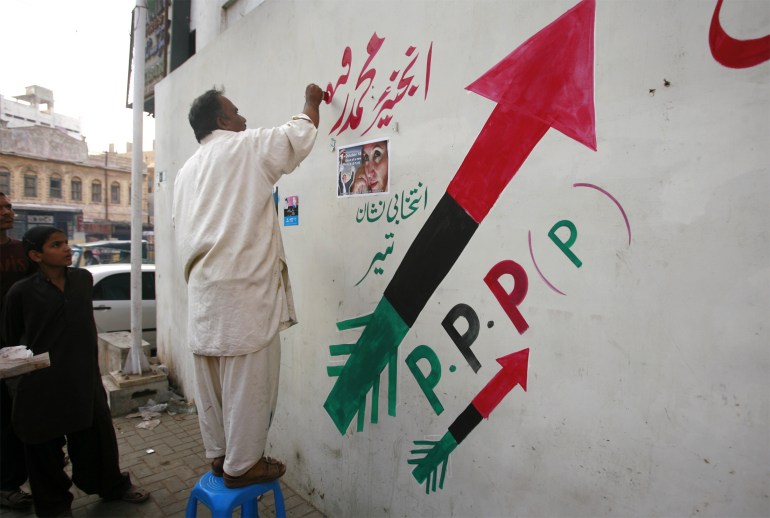Electoral symbols play an important role in a democratic process. As Pakistan gears up for general elections due next month, posters with party symbols can be seen plastered on utility poles and roadside walls across cities and towns.
Political parties have kicked off campaigning, plastering walls with propaganda posters but the symbol of what many believe is the country’s most popular party, the Pakistan Tehreek-e-Insaf (PTI), seems to be missing, thanks to an unprecedented crackdown on the PTI and its jailed leader, former Prime Minister Imran Khan. Khan’s party has been barred from using the party symbol in the elections scheduled for February 8.
PTI members and supporters say the blocking of its symbol, a cricket bat, is a ploy by the military-backed caretaker government to ensure the party’s defeat.
Meanwhile, the leader of the Pakistan Peoples Party (PPP), Bilawal Bhutto-Zardari, has also alleged that seven of his party’s national and provincial assembly candidates have being assigned the wrong electoral symbols in the eastern Punjab province. Bhutto claimed the Election Commission of Pakistan (ECP) acted under pressure from former Prime Minister Nawaz Sharif, who has been accused of cutting a deal with the country’s military that controls most levers of power from behind the scenes. Sharif, who returned to Pakistan in October after several years of self-imposed exile, has rejected the allegations.
So why are party symbols important, and will the ban on the PTI symbol harm the party?
Why did PTI lose its bat?
The ECP on December 22 omitted PTI’s bat symbol on the technical grounds that the party had not held intra-party elections – required under law. This rendered the party ineligible for having a symbol for the 2024 elections.
An intra-party election conducted by the PTI on June 8, 2022 was not recognised by the ECP on the grounds that it was not “just and fair”. The ECP also passed similar orders against 13 marginal political parties.
Critics and supporters of PTI have deemed it a deliberate attempt to curtail the party’s success in the elections. “The cricket bat was unjustly revoked through an illegal order,” PTI lawyer Syed Ali Zafar said.
An attempt by the PTI to get the ban overturned failed as Pakistan’s Supreme Court last week upheld the election commission’s decision, which is significant to the PTI because it is reminiscent of Khan’s success as a former cricketer.
Khan, who was the national team captain when the country won its only World Cup trophy in 1992, leveraged his successful sporting career to gather popular support as a politician.

Arif Rafiq, president of Vizier Consulting, a New York-based political risk advisory company, said the decision to block PTI symbol is “politically motivated”.
“They are part of a pattern of the Pakistani state using administrative measures, along with coercion, to deny PTI a pathway toward electoral victory,” he said, referring to the high popularity of Khan.
Nadia Malik, Head of Geo Television’s election cell, says that intra-party elections are a farce in Pakistan but the ECP did not hold other parties accountable, letting them scot-free.
“Losing a symbol is not something new in Pakistan but PTI can not even choose a different symbol for all their candidates,” as the deadline for that has passed, Malik told Al Jazeera.
The ECP has defended its decision saying the elections will be further delayed if the process of changing symbols continues.
To counter the confusion that this can create, the party’s social media team is working on a portal that allows voters to search for names and symbols of PTI’s candidates, Malik added. “PTI is really good at social outreach in that way.”
But one in every two Pakistanis does not own a smartphone, making it difficult for the PTI to reach out to voters.
“The end result of the ECP’s decision, and the Supreme Court’s ludicrous affirmation of it, is the disenfranchisement of millions of voters and the liquidation of the country’s largest party in the run-up to the polls,” Asad Rahim Khan, a constitutional expert, said.
“Flaws in intra-party elections don’t merit such a disproportionate punishment anywhere in the actual law. Even otherwise, Pakistan’s Constitution and clearly developed jurisprudence favour political parties and their right to contest.”
PTI Social Media Team has created a portal to search for candidate name & symbol. See video below showing a search for “NA1” & the results with candidate name & symbol. We are just waiting for data for each candidate before we go LIVE! #ChallengeAccepted #PrimeMinisterImranKhan pic.twitter.com/BhI4bOfIfJ
— PTI (@PTIofficial) January 14, 2024
The story behind the PTI bat
The slanted cricket bat symbol has a ubiquitous association with Khan’s party. However, the bat was not the party’s first symbol.
Malik from Geo TV said that the party’s first symbol was a lamp.
Before the 2013 elections, PTI wanted to use a double-balance scale as its electoral symbol, since it is the symbol of justice and “Insaf” roughly translates from Urdu to justice. However, the scales were the symbol of the Jamaat-e-Islami party in the 1970 general election. The legal battle for the symbol between the two parties ultimately tipped in Jamaat-e-Islami’s favour due to its historical claim on the scales.
After the 1977 general election, the military government of General Zia-ul-Haq deleted several electoral symbols from the approved list of symbols, the scales being one of them. These were restored by the ECP in 2010.
Why are electoral symbols significant?
The symbols that look like mere minimalist line work hold high stakes in Pakistan.
Malik, the journalist from GEO, pointed out that around 40 percent of Pakistan’s population is uneducated and voters who can not read rely on symbols to identify the party they want to choose on the ballot. “Even those people who can read names are not always as involved in campaigning, but they know their party’s symbol,” she said.
She added that parties’ electoral campaigning such as slogans and songs are built around their symbols.
For example, “Ballay ko diya kis nay sahara – Patel Para Patel Para” – which translates from Urdu to “Who supported the bat – Patel Para Patel Para” – was a slogan used by PTI to rally support from residents of Karachi’s Patel Para neighbourhood, according to analysis carried out by a faculty member of Islamabad’s COMSATS University in 2020.
Similarly, Sharif’s Pakistan Muslim League (Nawaz) (PML-N) and Bhutto-Zardari’s PPP have also curated slogans and songs around their symbols in the past. PPP’s catchy anthem “Dilan teer bija” translates from Balochi to “An arrow to your heart”, possibly alluding to the party’s arrow emblem.
The PML-N tiger
The centre-right PML-N party is strongly identified with the tiger symbol.
However, the tiger was not always associated with the party spearheaded by former Prime Minister Sharif.
The party was preceded by the right-wing alliance Islami Jamhoori Ittehad (IJI), which used the bicycle as its emblem. Malik said PML-N was unable to use the bicycle symbol.
Thus began the party’s extensive use of the tiger and imagery of lions and tigers became central to campaigning as Sharif earned the title “Lion of Punjab” — after the province where the PML-N has historically been most dominant — among party supporters. The party even brought a rare white tiger to public appearances, which died due to the sweltering Lahore heat in 2013.
In 2017 the PML-N nearly found itself in a situation similar to the one the PTI faces now. Its tiger symbol was barred over its failure to elect a new party chief after Sharif was dismissed as prime minister for his involvement in the Panama Papers scandal. But the election commission reversed its decision after PML-N elected a new chief.

A sword and an arrow – a Peoples Party’s story
The symbol of the social-democratic PPP was a sword during the 1970 election. A 2017 study by the faculty of the University of Punjab says that party founder, the late Zulfikar Ali Bhutto, chose the sword as a reference to Zulfikar, the sword of Ali bin Abi Taleb, the cousin and son-in-law of Prophet Muhammad and the fourth caliph.
This appeal to religious sentiments was made after Bhutto was accused of being anti-Islam for establishing a socialist party.
The sword was removed from approved symbols by Zia-ul-Haq, leading to PPP using the arrow.
However, in 2018, Bhutto’s grandson, Bhutto-Zardari, won a legal battle against a PPP breakaway faction to get the sword back. Which means the sword won’t be assigned to any other party.
For this election cycle, PPP’s symbol remains the arrow.

Balloons, brooms, bottlenoses
Apart from the main three parties – the PTI, PML-N and PPP, 145 other parties are also in the fray using symbols ranging from a broom to a wristwatch.
The Pasban Democratic Party initially wanted a grass broom as the party emblem to symbolise cleaning up the country’s corruption, but instead had to go with balloons, the Express Tribune reported.
The broom was instead allotted to Pakistan Awami Raj party, which is fighting on a platform of solidarity with the working class and in protest against feudalism.
Meanwhile, the ECP has offered symbols that are up for grabs, including the air conditioner, carrom board, deep freezer and the bottlenose dolphin.







